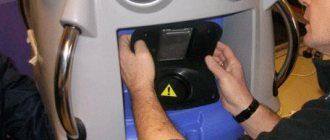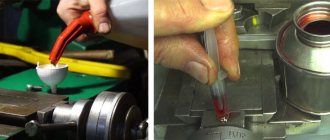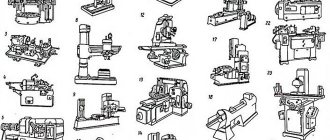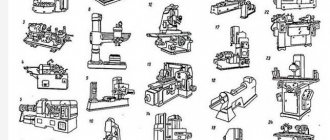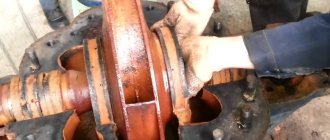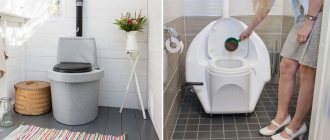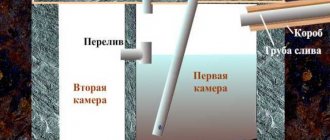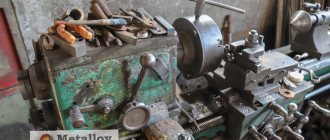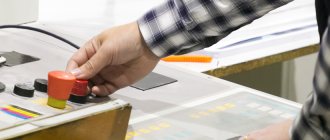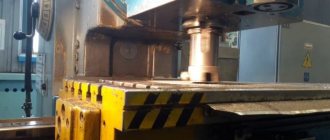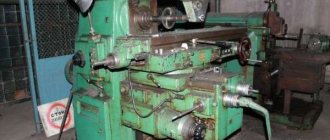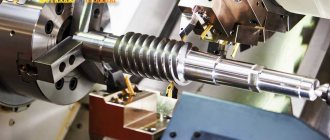Repair and maintenance of machines
The concept of maintenance of metal-cutting machines has always not been focused on one particular action. This is always a complex procedure, the composition of which is determined by the data of a specific situation. In general terms, this is a set of measures designed to maintain the enterprise’s equipment in maximum operating condition. Attention to such aspects allows you to:
- Significantly increase the service life of the machine park.
- Maintain the quality of products always at the highest level.
- To remove as much as possible from the technological chain the prerequisites for the occurrence of emergency situations, serious sudden breakdowns leading to equipment downtime and disrupting the routine flow of the production cycle.
- Ultimately, all the effort expended leads to savings for the organization and improvement of its supply chains.
Structure and nature of maintenance
All activities within the framework of maintenance are divided into two main sectors that complement each other:
- Preparation. This is a fairly diverse and very important layer, worked out. Includes planning the sequence and nature of actions, collecting information in order to determine the subtleties in the operation and design of machines, studying important documentation, compiling a list of necessary tools, drawing up a work schedule, studying and preparing various technical fluids and oils involved in the equipment. At the same time, a customer in St. Petersburg can contract with IP Emelyanov I.G. for additional diagnostics. As a rule, the need for it arises where high processing accuracy is required. Based on the results of the diagnostics, a report is drawn up, based on the results of which additional work will be carried out and a list of recommendations will be compiled regarding the intricacies of operating specific equipment.
- Direct maintenance. This is the practical part, consisting of a list of actions compiled based on the results of preliminary work. The personnel involved in this work are highly qualified and are able to carry out repairs of any degree of complexity. This applies to all members of the working group. Therefore, all types of equipment repairs and debugging will be carried out in the shortest possible time with proper quality. All customer wishes will be taken into account. Additional installation of equipment is possible.
At all stages of maintenance, participants are able to answer customer questions and adjust their actions based on the existing technical specifications.
At the end of the work, it is mandatory to test the equipment, check the functionality of all its systems and transfer it into operation with the compilation of a list of recommendations.
Work schedule
The terms and duration of technical work are regulated at the stage of signing the contract. If necessary, additional agreements may be concluded to regulate and supplement one or another aspect of the issue.
A typical maintenance kit includes cleaning, purging, lubrication, inspection, testing of safety systems, electrical inspection, determining the reliability of the grounding loop, setting up equipment, and testing it. This list may be supplemented with other works as agreed with the customer. A complete list of services provided can be found by downloading the additional application.
All technical parameters of the machine are then checked using high-precision measuring equipment, which allows faults to be identified at an early stage. With appropriate adjustments, more serious problems can be prevented.
The cost of work depends on the volume , service life of the equipment, frequency of routine maintenance, complexity of mechanisms and other factors.
It is possible to carry out both one-time maintenance and standard maintenance on an ongoing contractual basis. All questions that arise during the process can be discussed online using the site’s contact information.
Maintenance of metal cutting machines
Equipment system maintenance
Plant Maintenance
To ensure the operability of a machine-building enterprise, maintenance of industrial equipment is periodically carried out. The service life of a machine or machine is limited, and to extend it you need to monitor its technical condition, change consumables, and perform complex repair work.
Terms and Definitions
Equipment depends on the profile, power, and level of technical training of enterprises. For each type of production, repair and maintenance of industrial equipment, that is, a set of works that ensure serviceability and performance, differ in terms of timing and scope of work. Machine-building enterprises install equipment for the manufacture of parts and components, assembling components and products. For these purposes, machines and machines for metal forming, metalworking, welding are used, industrial robots, automated lines and CNC machines are used.
Military products are subject to increased requirements for manufacturing accuracy, reliability, and operating conditions. Enterprises in the aviation, space and other industries of the military-industrial complex carry out constant modernization of equipment and a high degree of automation of production, which requires special qualifications. A special feature of metallurgical enterprises is the large dimensions of the units and increased loads during operation.
How to carry out maintenance of industrial equipment, the frequency and scope of work is determined by the enterprise itself, taking into account the requirements of the manufacturer’s documentation, GOST 18322-78 “System for maintenance and repair of equipment. Terms and definitions" and recommendations adopted for individual industries. For these purposes, a system of scheduled preventive maintenance is being developed. Based on the time it takes to carry out maintenance of industrial equipment, it is divided into:
– Daily, including inspection and keeping clean;
– Regulated, provided for in the unit’s passport and performed seasonally or during operation and consisting of changing the oil and quickly wearing parts, adjusting and checking operation;
– Unregulated, caused by deviations detected during inspection or checking the readings of diagnostic systems.
The task of industrial equipment maintenance and repair is the prevention of failures and troubleshooting. Work is carried out according to the event when a breakdown is detected, in accordance with the regulations or according to the technical condition of the equipment. The frequency of repairs is calculated for various machines and units. Metal-cutting machines are repaired every 8640 operating hours, forging machines and machines with asynchronous motors 4320 hours, electric foundry furnaces from 1440 to 2880 hours. At the same time, consumables, worn out and failed parts are replaced.
Initial data
Repairs are planned and carried out on the basis of operational documents prepared in accordance with GOST 2.601-2013 “Unified system of design documentation. Operational documents": technical passport or operating manual, as-built documentation (diagrams, drawings of the unit, its components and parts), cost estimates.
The passport contains information on how to install and maintain industrial equipment, the timing and scope of work. When a machine or machine is put into operation, it is assigned an inventory number and a passport is created, in which data on the repairs performed is entered, and a list of replaced parts is indicated.
Features and differences
According to the degree of complexity and volume of work, repairs are divided into:
– current, including the replacement of individual easily removable parts, liquids, lubricants and consumables;
– capital, which requires complete or partial disassembly of industrial equipment; any parts and assemblies, including basic ones, are subject to replacement.
content .. 11 12 16 ..§ 16. Maintenance and repair of machines
The serviceability and performance of machines during the established service life is ensured by a system of their planned preventive maintenance and repair (PMR). The PIR system is a set of organizational and technical measures to prevent failures, damage and increased wear of machine parts, as well as to restore their impaired performance.
Organizational and technical measures are developed and carried out with mandatory consideration of the manufacturer’s recommendations set out in the operational and repair documentation, as well as the requirements for the technical condition of machines and the rules of safe operation established by the USSR State Mining and Technical Supervision and current state and industry standards. For imported machines, the requirements of the relevant documentation from the manufacturer are mandatory.
The PPR system provides for mandatory planning, preparation and implementation of the necessary types of maintenance and repair of each operating machine with a given sequence and frequency. All this ensures stable operation of the machines, prevents accidents and unscheduled downtime. A distinction is made between shift-based maintenance and scheduled maintenance (periodic) maintenance.
Shift Maintenance (MS) is performed before, during, and after a work shift. It involves systematic monitoring of the condition of the machine, compliance with the requirements of the factory or manufacturer’s instructions for its operation, elimination of minor faults, adjustment of mechanisms, lubrication of rubbing parts and shift shifts. Shift maintenance is carried out during the work shift, respectively, by the milling operator or grinder-polisher to whom the machine is assigned, or centrally by specialized teams (units) of the service of the chief mechanic, and sometimes the chief power engineer of the enterprise during off-shift hours.
Maintenance (TO) is carried out as planned after a certain number of operating hours of the machine established by the manufacturer. It includes work required for shift maintenance, as well as adjustment of the main mechanisms of the machine, replacement of faulty seals, belts, small parts, etc. Maintenance is usually carried out during off-shift hours or on weekends.
The impaired functionality of the machine is restored during the process of scheduled repairs, which are divided into current (T), medium (C), and major (K) repairs, of which T and K are used in stone processing production.
Current repairs ensure guaranteed operability of the machine until the next scheduled repair, by restoring and replacing individual assembly units (assemblies) and parts to an extent depending on the technical condition of the machine.
Overhaul ensures the serviceability and restoration of the full (or close to full) service life of the machine by repairing or replacing assembly units (assemblies) and parts, including basic ones.
The types of maintenance and repair, the frequency of their implementation, as well as the composition and procedure for performing maintenance and routine repairs of stone-processing machines are specifically established by the manufacturer in the operational documentation for each machine model. The procedure for carrying out major repairs, technical conditions for it, requirements for technology and organization of work, as well as the quality of repaired machines are regulated by repair documentation approved by the manufacturer.
To ensure scheduled preventative maintenance and repair of machine tools, plans for maintenance and repair, organizational and technical measures are developed to ensure timely completion of maintenance and repair work within the time frame established by the plan with minimal labor and material costs. Systematic recording of machine operating hours and monitoring the implementation of maintenance and repair plans is organized.
Stone processing enterprises must develop annual and monthly plans and schedules for the maintenance and repair of machines.
The annual plan determines the number of scheduled maintenance and repairs for each machine. On
based on it, the need for material and labor resources is calculated. When developing an annual plan, the initial indicator is the operating time of the machine in hours:
actual at the beginning of the planned year from the time the corresponding type of maintenance (repair) was carried out or from the start of operation of the machine;
planned for the year, to obtain the value of which the planned number of hours of working time of the machine during the year is multiplied by the coefficient of intra-shift use.
The monthly schedule, which is approved by the chief engineer (or chief mechanic) of the enterprise, indicates the date of shutdown of each machine for maintenance, repairs and repairs and the duration of its downtime in days. Maintenance is an important preventive operation, which helps to increase the service life of machines and their turnaround time, and also reduces the volume and cost of repair work.
A special place in maintenance is occupied by the lubrication of the rubbing surfaces of machine parts, on the correctness and timeliness of which its durability and operational reliability depend. Each machine has individual requirements for lubrication, which are contained in the manufacturer’s instructions and in the lubrication chart attached to the technical documentation for the machine. The instructions determine the timing and methods of replacing or replenishing lubricants, checking the presence and sufficiency of lubricant. The lubrication card indicates all points and places to be lubricated, methods for lubrication of each place, the name of lubricants and the standard number for them, the frequency of checking and lubrication of each part (assembly) of the machine. The standards for lubricants contain requirements for their physical and chemical properties and establish the permissible content of mechanical impurities. The lubrication map consists of the rules and lubrication diagram of the machine, and the numbers of lubrication points. The effectiveness of lubrication is determined by the ability of the oil to create a continuous film between the rubbing surfaces of machine parts. Even a slight rupture leads to contact between the rubbing surfaces, which causes a sharp increase in
friction between them and, as a result, overheating, rapid wear and even breakage of machine parts under significant loads.
Lubricants, filling equipment (oilers, syringes, etc.) and moving parts of the machine must be protected from contamination by dust, dirt and abrasive sludge generated during stone processing. If protection is insufficient, sludge, splashing with water, can enter the lubrication zone, forming together with the lubricant an emulsion saturated with abrasives, which causes intense wear of the rubbing surfaces. To protect machine parts from corrosion, lubricated surfaces must be protected from water.
The nature of the work during current or major repairs of a car is determined by its design and the degree of wear of parts and assemblies that must be restored or replaced during this repair. During routine repairs, they repair or replace parts worn out during the period between repairs or multiples thereof, and adjust the machine, ensuring its normal operation until the next scheduled repair. During a major overhaul, the machine is completely disassembled, worn parts and components, including basic ones, are repaired or replaced, and its accuracy, power and productivity are restored.
Before stopping the machine for major repairs within the time limits provided for by the plan, its technical condition is checked by a commission chaired by the chief engineer (or chief mechanic) of the enterprise. If the technical condition of the machine allows for repairs not to be carried out on time according to the schedule, then the commission gives permission for its further operation and sets a new date for the next inspection or shutdown of the machine to carry out the appropriate type of repair.
If unscheduled repairs are necessary due to failure of machine components, when its operating time is 80% or more of the established frequency of routine repairs or maintenance, the machine can be stopped for the next routine repair or maintenance with appropriate adjustments made to the monthly schedule.
Each stone processing enterprise must have a mechanical repair base (workshop) to carry out the planned scope of work on the maintenance and repair of machines in accordance with the requirements contained in the operating documentation of the manufacturer.
Acceptance of the machine after maintenance or routine repairs is carried out, respectively, by the milling operator or grinder-polisher to whom the machine is assigned, as well as by the workshop mechanic through an external inspection and testing of the operation of the machine at idle and under load. The delivery and acceptance of completed work is documented by entries about their volume in the maintenance and repair logbook and in the fault logbook, as well as the signatures of the responsible persons handing over and accepting the work.
Major repairs of machines, as well as their assembly units using the aggregate-unit method at large stone-processing enterprises that have a powerful repair and mechanical base, are carried out by the enterprises themselves, and in other cases they are carried out centrally at repair and mechanical enterprises, in accordance with the requirements set out in repair documentation approved by the manufacturer. Delivery of machines to a repair enterprise or to the repair department of an operating enterprise for acceptance after repair must meet the requirements of GOST 19504-74 and amendment No. 1 of GOST 19504-74 “Procedure for handing over for overhaul and release from overhaul.”
The PPR system, aimed at preventing machine malfunctions, still cannot completely eliminate their unexpected occurrence during operation of any machine. Each machine has its own design features and its most common faults, a list of which is usually given in the technical documentation attached to it. The machine operator must familiarize himself with this list when studying the design of the machine. Noticed malfunctions can be eliminated by the machine operator, as well as by electricians or mechanics on duty.
Maintenance of metal cutting machines
Our company carries out comprehensive work on diagnostics, adjustment and maintenance of metal-cutting machines of domestic and foreign production, in accordance with the technical requirements of GOST and manufacturers.
The range of machine maintenance work carried out by our specialists is wide, allowing the equipment to operate much longer, without emergency and unplanned stops.
By choosing Stanko-Service LLC for machine maintenance, you are guaranteed to receive high quality work at the best price.
The main work performed during diagnostics and maintenance of metal-cutting machines
1. External inspection without disassembly to identify defects, condition and operation of the machine as a whole.
2. Washing, wiping the machine guides, oiling all surfaces.
3. Checking the correct switching of the speed and feed handles. Necessary adjustment based on the results of the inspection.
4. Checking the correctness of switching and execution of commands issued from the control panel (for CNC machines).
5. Checking operation in all cutting modes (at idle speed).
6. Inspection of the condition of guide carriages, traverses and other rubbing surfaces.
7. Tightening loose fasteners. Carrying out the necessary adjustments.
8. Tightening loose fasteners of shafts and lead screws. Carrying out the necessary adjustments.
9. Checking the serviceability of limiters, switches, stops and other automatic devices.
10. Checking the belt tension. Carrying out the necessary adjustments.
11. Checking the presence and serviceability of protective devices (safety shields, casings and other elements).
12. Checking the absence of vibration of equipment components. Make adjustments if necessary.
13. Checking the noise level of equipment.
14. Checking the heating of bearings. Based on the test results, adjust the tension or draw up a report on the need for replacement.
Table 10.1 Failures of lathes and ways to eliminate them
| Failures of lathes and their causes | Remedies |
Turning of cylindrical surfaces | |
| Taper of the machined surface: misalignment of the tailstock quill with the spindle axis; large overhang of the workpiece from the chuck jaws, due to which it is pressed out; spinning of the cutter in the tool holder; increased wear of the cutter | Align the axes of the tailstock quill and the spindle. Press the workpiece with the rear center, use a continuous thrust cutter. Securely fasten the cutter. Replace the cutter, reduce the cutting conditions. |
| Out-of-roundness of the machined surface: uneven wear of the front spindle bearing | Repair the machine |
| Barrel shape of the machined surface: deflection of a non-rigid shaft | Reduce cutting depth and feed; use a continuous thrust cutter and an additional support-rest; set the cutter above the center line |
| Saddle shape of the machined surface: spinning the rear center | Reduce the overhang of the quill and secure it firmly |
| increased wear of the guides at the tailstock, the rear center is located lower than the front | Repair the machine |
| Deviation from the alignment of the surfaces of the part: radial runout of the working surfaces of the chuck jaws or the front center | Boring the chuck jaws; use a split bushing, bored to the diameter of the workpiece surface to be fixed; replace the front center or grind its working cone in place |
| Blackness on the processed surface: small allowance | Check the workpieces and, if necessary, change their size |
| increased workpiece curvature | Reject unusable workpieces |
| workpiece displacement in the chuck | Reinstall the workpiece |
| displacement of the center holes relative to the workpiece axis | Eliminate misalignment of center holes |
| Unsatisfactory roughness of the machined surface: high feed; low cutting speed | Set the correct cutting conditions |
| small radius of curvature of the cutter | Install a cutter with a large radius of curvature of the cutter tip |
| cutter worn out | Sharpen the cutter |
| non-rigid attachment of the cutter to the workpiece | Reduce the protrusion of the cutter from the tool holder; apply a more rigid fastening of the workpiece on the machine |
| increased clearances in caliper guides | Adjust the gaps in the caliper guides |
End processing | |
| Deviation from flatness of the end: large depth of cut and feed | Finish the end face at a low depth of cut and feed. If the results are positive, it is necessary to change the modes |
| non-rigid cutter attachment | Reduce the protrusion of the cutter from the tool holder |
| lateral shift of the support during cutting | Attach the carriage to the bed |
| The end is not perpendicular to the axis of the part: the workpiece is skewed in the chuck | Reinstall the workpiece in the chuck |
| Part of the end remained unprocessed: small allowance | Check blanks |
| skewed end of the workpiece or incorrect installation in the chuck | Select suitable blanks. Correctly install the workpiece in the chuck |
| Unsatisfactory roughness of the machined surface: deflection of the part under the influence of cutting forces | Reduce cross feed |
| Unsatisfactory roughness of machined surface: large or uneven feed | Reduce feed |
| work without coolant | Apply coolant |
| high cutter wear | Apply coolant Replace cutter |
Repair and maintenance of metal-cutting machines
Book title: Repair and maintenance of metal-cutting machines Publication: Moscow, MASHGIZ Author: A.S. Minkin Year of printing: 1953 Number of pages: 233 Format: Djvu
The book discusses the issues of caring for machine tools, technological processes for restoring parts and repairing metal-cutting machines, ways and means of mechanizing repair work and methods for checking machines after repair. The book is intended to improve the skills of mechanics - repairmen, and will also be useful to workers - machine operators working on metal-cutting machines.
A powerful factor in reducing the cost of industrial products, accelerating the turnover of working capital and preserving the fixed assets of socialist enterprises is the rational operation and repair of equipment. The mass movement of leading people in production for a high culture of operating equipment has proven the full possibility of significantly reducing the volume of repairs and increasing the durability of machines, machine tools, etc. d. Many enterprises have achieved a significant reduction in the labor intensity of repairs and a reduction in the cost of repairs through the introduction of advanced technological methods and mechanization of repair work.
Innovators of production at industrial enterprises in Moscow, Leningrad and other cities show a lot of creative energy. They strive to further increase labor productivity, save materials, fuel, and electricity. Carefully thinking through and rationalizing the processing process, they widely use various devices, process parts simultaneously with several cutters, personally take part in preventive inspection of the machine, etc. Proper organization of equipment care, the use of advanced technology for repair work, mechanization of repair operations and proper organization of labor in repair shops open up great opportunities to reduce the volume and cost of repair work, as well as downtime of machines during repair.
Advanced repair technology also requires strict adherence to accuracy standards for machines produced for repair. Accuracy standards are given on the basis of data for a number of factories with different organization of repair facilities, their equipment, and taking into account the standards specified in GOST, instructions and regulations for scheduled preventive maintenance. Every mechanic who repairs metal-cutting machines must have a good knowledge of all the basic processes associated with dismantling machines, restoring and repairing parts, as well as assembling and testing machines released from repair. He must know the systems of planned preventive maintenance, materials used for the manufacture and repair of parts, devices and mechanisms used in the repair of parts, etc.
In this regard, a network of schools to improve the skills of workers is currently widely deployed at factories. This circumstance necessitates special literature for workers covering the practice of repair work. The existing literature on this issue is mainly intended for engineering and technical workers. The author has set himself the task of filling this gap in this book.
eom07_0_operating rules
3
Lecture 1 Pages 34 Drawings
20.07.19
General rules for the operation of metal-cutting, woodworking and press-forging equipment
Equipment of all types must be used only in accordance with its technological purpose specified in the technical documentation.
Only qualified workers and adjusters who have studied the design and technological features of the machines and the rules of technical operation, have undergone special instructions, passed the exam of the factory qualification commission and received a special certificate for the right to work on these machines can be allowed to work on metal-cutting, woodworking machines, forging and pressing machines. .
Operation of metal-cutting machines
Metal-cutting machines, regardless of the accuracy class, should be used to perform a range of work limited by: the technological purpose of the machine, the accuracy and roughness of the machined surfaces ensured, the maximum loads allowed by the machine from processing parts.
On machines of classes B, A and C, you can only perform those types of work that are specified in the factory manuals.
Machines of a higher accuracy class should not be used to process parts that, according to the accuracy specified in the drawing, can be processed on machines of a lower class.
On machines whose design provides for securing the workpieces on a moving table (milling, boring, jig boring, surface grinding, rotary, etc.), it is prohibited to process parts whose weight exceeds that specified in the operating manual, in order to avoid premature wear of the guides or the formation of scoring on them. The same requirement applies to machines whose design involves securing parts in centers or in chucks on the spindle (lathes, cylindrical grinders, gear-cutting machines, etc.), in order to avoid premature wear of spindle bearings and loss of accuracy.
Unconditional adherence to this rule is especially necessary in relation to precision machines, since wear of only a few micrometers is unacceptable for them.
Pre-processing of holes to be bored on jig boring machines should be done on drilling, milling and boring machines of normal accuracy, leaving a boring allowance of 2-2.5 mm per side.
On jig boring machines, it is prohibited to mill planes to avoid loss of coordinate setting accuracy. Because the movement screws of tables, traverses and spindle heads serve simultaneously to measure movements.
To ensure uniform wear on tables and measuring screws, it is recommended that when processing small parts, they are secured to different areas of the table.
It is not recommended to process parts whose plan dimensions exceed the table dimensions on jig boring machines. It is especially undesirable to process on single-column machines parts whose width exceeds the width of the table and which hang to one side.
It is also not allowed to overtighten the nuts of the part by reinforcing the wrench with the help of various extensions. It is prohibited to place parts and tools on the tables of precision machines, as well as on the guides of metal-cutting machines, regardless of their accuracy class.
Parts processed directly on the tables of jig boring machines should be installed on special measured hardened, ground and finished spacers with a thickness of at least 25 mm.
Before installing the part, the table mirror, gaskets and base surface of the part must be checked and thoroughly wiped down.
While the machine is operating, the surface of the table that is not covered by the part must be covered with special shields to protect it from accidental damage.
In order to increase the accuracy retention period of gear grinding and thread grinding machines of classes A and C, it is not recommended to process parts with the maximum permissible diameter according to the passport and at extreme cutting conditions.
Workpieces to be processed on machines intended for finishing must be free of corrosion, scale, and molding sand burns. When machining on precision machines, the base surfaces of parts must be cleanly machined.
After installation on the machine spindle, the abrasive wheel must be balanced and checked by rotating for at least 5 minutes at idle speed with the housing closed.
When working with cooling, the entire working surface of the wheel must be washed with coolant. The use of coolants that destroy the wheel bond is prohibited.
When working with abrasive wheels on various machines, you should follow the safety rules provided for by GOST 12.3.028-82*.
Each grinding and sharpening machine must contain instructions for installing and operating grinding wheels. It is not allowed to operate machines with dull tools.
It is necessary to check the condition of the surfaces of the shanks of tools and accessories issued impersonally from the tool storerooms, and fixed in the conical holes of the spindles and quills of machines of classes N and P, on a daily basis.
Similar precision machine tools and accessories should only be used on the machine for which they were manufactured.
Before installing tools and accessories, their taper shanks and taper sockets of machine spindles and quills must be checked and wiped. It is strictly forbidden to use tools and accessories that have even slight damage to the shanks (scratches, nicks, marks).
Operation of press-forging machines
When installing stamps, the following requirements must be followed:
the machine load should not exceed the rated value of the main parameter; To do this, the calculated stamping force must be increased by 20-30% and when installing the stamp, select the nearest machine with the greatest force;
force reserve is necessary to avoid overloading and jamming of the machine due to inaccuracy of calculation formulas, fluctuations in the temperature of stampings, dullness of dies, etc.;
the maximum amount of work spent on performing the operation should not exceed that allowed according to the machine’s passport;
The eccentricity of the load applied to the slider should be minimal.
Before starting the machine, you should check whether there are any foreign objects in the work area.
Overheating of bearings and other rubbing parts, electric motors and coils of electromagnets and relays is not allowed.
It is not allowed to increase the air or working fluid pressure above the permissible values specified in the machine’s operating manual.
When operating crank forging machines with pneumatic clutches and a brake, it is necessary to ensure correct locking, i.e., the clutch is turned on after the brake is turned off and the brake is turned on after the clutch is turned off.
Jamming (stuck) of crank machines is not allowed. The most common causes of jamming are:
- overloading of the machine due to an unacceptably dull tool;
- stamping of blanks at low temperatures
- (a decrease in stamping temperature by 100 °C causes an increase in load by 1.5–2 times);
- operation when the air pressure in the brake and clutch control system decreases;
- malfunction or violation of the reliability of the tool fastening;
- simultaneous feeding of two blanks into the die space on sheet metal stamping presses and the entry of foreign objects into the die space;
- violation of the reliability of the stopper of the die space adjustment mechanism (adjusting screws) and the stroke of the slider (eccentric bushings);
- low flywheel speed.
When working with stamping hammers, strong impacts of the upper half of the die on the lower half are not allowed.
When working on forging hammers, hard impacts of the striker against the striker are not allowed.
It is not allowed to work on the machine when the tool is loosened, or when the gaps in connections and mechanisms are higher than permissible.
Importance of machine tool lubrication
Rational organization of lubrication facilities and regular lubrication of equipment components and parts reduce their wear, reduce machine downtime, and reduce the cost of repairs.
Until recently, many machines were produced with large safety margins, which ensured their performance with relatively moderate requirements for lubricant quality.
Now, when in mechanical engineering there is a struggle to increase reliability, reduce the weight and dimensions of machines, they are designed for large specific loads and, accordingly, for smaller safety margins.
Reliable operation of machines can only be ensured if there are trouble-free lubrication devices and the use of high-quality lubricants. Therefore, when repairing, modernizing and operating equipment, great attention should be paid to the selection of lubricants and the choice of lubrication devices.
Compliance with rational lubrication regimes, timely cleaning and lubrication, control of the operation of lubrication devices significantly extends the service life of parts and assemblies.
Modern equipment is equipped with a variety of lubrication systems, hydraulic drives, and complex lubrication devices and devices. A wide range of lubricants are available.
Maintenance and repair of CNC machines
Maintaining the technical level of machine tools guaranteed by manufacturers is impossible without strict compliance by consumer factories with a set of requirements for the operation of equipment and the implementation of a rational system of maintenance and repair. The implementation of such requirements makes it possible to minimize both the amount of repair and maintenance costs and production losses associated with equipment downtime due to its malfunction.
Maintenance
Maintenance includes work to maintain the functionality of machines and machines during storage, transportation, preparation for use and operation. Maintenance also includes supervision of the correct equipment of the room in which the machine will be used. Along with planned mandatory work, maintenance also includes work performed in the event of random failures. Work to restore the serviceability of equipment is called repair.
Various types of maintenance work on the mechanical, electrical and electronic parts of the machine are performed by repairmen, electricians, electronic engineers, operators, and lubricants. The service technician must be able to perform all types of scheduled and unscheduled maintenance work assigned to the listed personnel.
Scheduled inspection
A scheduled inspection (O) is carried out to check the condition of the components and devices of the machine, to obtain and accumulate information about the wear of parts and to change the nature of their connections, necessary for the preparation of upcoming repairs. A scheduled inspection is carried out after a certain number of hours of machine operation, usually visually without disassembling the components. During inspection, minor faults are eliminated.
Repair of metalworking CNC machines
- News
- Articles
JSC GRS Ural carries out both major repairs of machines and partial replacement of parts, troubleshooting and modernization of equipment.
Overhaul of horizontal boring machines is carried out in several stages:
· complete disassembly of the machine for a detailed inspection and identification of the cause of problems;
· assessment of the degree of wear of parts;
· diagnostics of malfunctions and malfunctions in electronics and automation;
· drawing up a repair plan;
· replacement of worn parts and components;
· assembly, adjustment, testing of equipment under load;
· if necessary, modernization of machines is carried out.
The timing of repairs of CNC machines depends on the complexity of the problems and the planned work, as well as the type of equipment.
Overhaul of CNC machines will allow you to restore the technical characteristics of the equipment corresponding to the passport data. Timely repair of the machine will increase its service life, increase productivity, and restore factory parameters.
Repair of boring machines and other equipment consists of dismantling and disassembling all components, washing, cleaning components in accordance with the standards established by the manufacturer. The final stage is the assembly of the machine, quality control of its assembly and running-in of the equipment.
Timely repairs and maintenance are necessary for reliable and smooth operation of any equipment.
The list of works includes:
· primary inspection and diagnostics of equipment, allowing to identify places of wear, find various cracks, bends, chips;
· maintenance of machines, which is carried out with the help of qualified personnel in full compliance with the standards and requirements of the manufacturer;
· planned and overhaul of CNC machines, during which specialists will restore the damaged geometry and performance of the equipment and will be able to carry out a set of repair tasks at the customer’s enterprise.
Thanks to modern measuring equipment, after repair, specialists will measure the geometric accuracy of the machine, the full coordination of the mechanisms, the trajectory of their movement, necessary to return the maximum accuracy of all processes.
The electronic part of the equipment with program control also requires special attention. Therefore, a thorough diagnosis of the electronic system will be carried out, and if necessary, the power cable, contact groups and other parts will be replaced.
Production operation of machines
Home » Articles » Professionally about metalworking » Metal-cutting machinesWe recommend purchasing:
Installations for automatic welding of longitudinal seams of shells - in stock!
High performance, convenience, ease of operation and reliability in operation.
Welding screens and protective curtains are in stock!
Radiation protection when welding and cutting. Big choice. Delivery throughout Russia!
During the operation of metalworking machines that have a flexible drive from an electric motor to a gearbox, there is a need for periodic tensioning. The flexible drive can be V-belt, belt or chain drives. During operation, the forces on the belt or V-belt drive stretch them, and consequently, there is a loss of speed on the drive shaft, which also leads to a loss of power on the spindle. During operation, the drive chain wears out in the links, which leads to elongation and, consequently, excessive sagging, as a result of which the chain can jump off the sprockets. To regulate the tension of flexible gears, the electric motor must be installed on a slide, moving it along the guide slides, slightly increasing the center-to-center distance, thereby tensioning the flexible gear. If the chain is too worn out, it must be replaced, since the teeth of the sprocket will hit the connecting rollers of the chain, which will lead to its rupture.
Disc friction clutches
are subject to regulation during operation. The disks must be tightly connected to each other when turned on and free after turning off. If, when adjusting the friction clutches, the discs are over-tightened, then in the process of turning them off, increased friction is created, and consequently, a high temperature occurs, which leads to rapid wear of the discs. If the tension is not sufficient, then during the switching process the discs slip, which also causes increased temperature and excessive wear. The final adjustment of the disc friction clutches is carried out during the load test of the machine.
Adjusting the spindle group of the machine
must be carried out not only after a major overhaul of the machine, but also during its operation. During operation of the machine, wear occurs on the tapered roller bearings, which bear the main load during cutting. As a result of the formation of increased clearance in the bearings, vibrations of the spindle occur and the quality of the surface of the workpiece deteriorates. To eliminate the gap, unscrew the screw, which is designed to lock the spindle nut, and tighten the nut, which acts on the thrust ring, and the ring on the bearing race, displacing it along the spindle axis until the desired gap is established. When rotating the spindle manually, it should not cause additional force as a result of excessive clamping of the bearings.
Adjusting the caliper group
. During the operation of the calipers, due to wear of the rubbing surfaces, it is periodically necessary to adjust them. To reduce the amount of fitting work during the adjustment process, wear compensators are used. In Fig. 208 shows wear compensators, with the help of which the support group of the machine is regulated. In Fig. 208, and shows a non-adjustable clamping bar 1, pressed to the table with a fastening screw 4 in such a way as to ensure a normal gap between the wearing surfaces 2 and 3. In Fig. 208, b shows the design of the adjustable wear compensator of the clamping bar 6 with the set screw 5. First, the fixed bar 1 is pressed with the fastening screw 4, while the gaps 2 and 3 are adjusted by screw 5. In Fig. 208, in which the compensator is the rhombic strip 1, and the gap 2 and 3 between the rubbing surfaces is adjusted by the setscrew 4. K is the largest permissible gap between the rhombic strip 1 and the caliper. In Fig. 208, d shows a rhombic adjustable compensator; it is pressed with screw 6 to the caliper, and the gap between the rubbing surfaces is adjusted with screw 5. In Fig. 208, d shows a wear compensator, which is a wedge 2. Using screw 1, the wedge 2 moves to the right and the gap 3 and 4 between the mating planes is reduced. After setting the normal gap, use screw 5 to fix wedge 2.
Rice. 208. Wear compensators
Restoring the accuracy of guide frames
carried out during the process of their repair. First of all, it is necessary to determine what repairs should be made to the guides subject to restoration, and then decide on the method of their restoration. If the guides of a screw-cutting lathe with a width of up to 100 mm and a length of up to 1000 mm have an error of 0.15 mm, then they must be restored by scraping. As the error increases, the guides must be processed by cutting on a planing, milling or grinding machine. Grinding and planing operations can be final if planing is done with wide cutters at a small depth of cut and high feed. After milling, it is necessary to scrape along a control ruler for paint. The quality of scraping is determined by the number of points in a 25x25 mm square. For sliding guides up to 120 mm wide, the number of spots must be at least 16, and for a frame width up to 250 mm - at least 10. If the bed guides have a hardened surface, then instead of scraping, their surfaces are ground and less often lapped. Restoring the accuracy of various machine tools through repair is an important issue that is described in the specialized literature.
